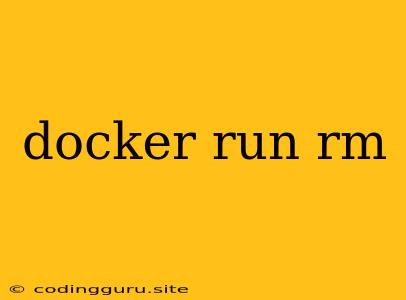Docker: Running and Removing Containers with Ease
Docker is a powerful tool for creating and managing isolated environments for your applications. A key part of using Docker is understanding how to run and remove containers. This article will guide you through the basic commands and concepts you need to know.
Understanding Docker Containers
Before diving into the commands, it's crucial to understand what a Docker container actually is. Imagine a lightweight virtual machine that only contains your application and its dependencies. Containers are isolated environments, meaning changes made inside a container won't affect your host system.
Running Docker Containers: The docker run Command
The docker run command is the fundamental way to start a Docker container. Here's a basic example:
docker run -it ubuntu:latest /bin/bash
Let's break down the command:
docker run: This is the core command to execute a Docker container.-it: These flags are used to create an interactive terminal session inside the container.-iprovides input and-tallocates a pseudo-terminal.ubuntu:latest: This specifies the Docker image to use. In this case, we're using the officialubuntuimage tagged aslatest./bin/bash: This is the command to execute within the container. We're starting a bash shell.
Running Specific Commands:
You can also use docker run to execute a single command without starting a shell session:
docker run ubuntu:latest /bin/echo "Hello from Docker!"
This command will run the echo command inside the container and print the message "Hello from Docker!" to the console.
Removing Docker Containers: The docker rm Command
Once you're done with a container, you'll need to remove it. The docker rm command makes this easy. The basic syntax is:
docker rm
Replace <container_id or container_name> with the ID or name of the container you want to remove.
Removing Multiple Containers:
You can remove multiple containers simultaneously by listing their IDs or names separated by spaces:
docker rm container_id1 container_id2 container_id3
Removing All Containers:
If you want to remove all stopped containers, use the --all flag:
docker rm --all
Removing Running Containers:
By default, you can't remove a running container. You'll need to use the -f or --force flag to stop and remove it:
docker rm -f
Important Note: The -f flag will forcefully stop the container without allowing it to shut down gracefully. This may lead to data loss or unexpected behavior.
Tips for Using docker run and docker rm
- Container Names: It's a good practice to give your containers meaningful names. This makes it easier to manage and remove them.
- Cleanup: Regularly remove unused containers to keep your system clean and avoid resource exhaustion.
- Automated Cleanup: You can create scripts or Docker Compose configurations to automatically remove containers after they've finished running.
Examples of Using docker run and docker rm
Example 1: Starting an Nginx server
docker run -d -p 80:80 nginx:latest
- This command starts an Nginx web server in the background (
-d) and maps port 80 on your host machine to port 80 inside the container (-p 80:80). - To remove the Nginx container later, use:
docker rm
Example 2: Running a Python script within a container
docker run -it python:3.9-slim /bin/bash -c "pip install requests && python my_script.py"
- This command starts a Python container, enters an interactive shell (
-it), installs therequestslibrary, and then runsmy_script.py. - After the script finishes, you can remove the container:
docker rm
Conclusion
The docker run and docker rm commands are essential for working with Docker containers. Using them effectively can significantly enhance your productivity and streamline your development process. Remember to clean up your unused containers regularly to maintain a healthy Docker environment. By mastering these fundamental commands, you can confidently manage and utilize Docker containers for various tasks.
